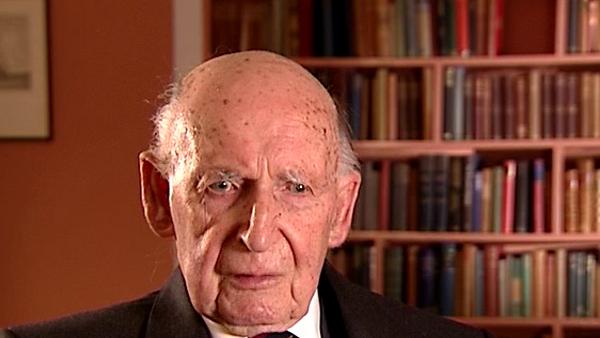NEXT STORY

Work on meteors at Jodrell Bank: Looking at fluctuations
RELATED STORIES

NEXT STORY

Work on meteors at Jodrell Bank: Looking at fluctuations
RELATED STORIES



The other thing that happened during that period – I'm talking about the early days at Jodrell, this is before we began serious work on building the telescope in 1952 – we... we had measured the... we could measure radiant position of meteors by altering the position of Clegg's steerable aerial, and in order to do... make a continuous observation, we built a... a series of yagi aerials, two groups, one, one each side of what we called the radiant hut. It still exists at Jodrell, and each side of that hut we built an array of yagi aerials inclined to the... inclined to one another and we... the continuous photography of the tube and we could observe meteors with... with no need to note down in a notebook, note in a book every time we saw a meteor. We would simply photograph them and record it on film. And by that means we could record automatically not only the shower meteors, but all the... the meteors moving in... in groups, so to speak, and all the regular meteor showers showed up very well, beginning with the Quadrantids, the short period of time in January and moving on through the Lyrids in April, Perseids in August and... and the Taurids there, and it's in November and the... and the Quadrant... and the... and the Geminids in December.
We also investigated quite a lot of very minor meteor stream. Just before Christmas each year, Becvar meteor stream, and... but the... the extraordinary thing was this, that after the Lyrids in April, there was no record of any significant meteor shower until the Perseids in August, but to our amazement on this automatic recording device, after the Lyrids had gone, the... the occasional sporadic meteors, about a few an hour still occurred, but suddenly there emerged enormously powerful streams of meteors and these were... had never been observed by eye for the simple reason that they were occurring in daylight, and so we had the good fortune to discover the daytime meteor showers, most powerful showers, one of which was important because it was the equivalent of the... the daytime equivalent of the night time Orionids which occurred in October. Now, that was quite... quite important in those days and, again, you will find a series of papers about that in the... in the monthly notices.
Bernard Lovell (1913-2012), British radio astronomer and founder of the Jodrell Bank Observatory, received an OBE in 1946 for his work on radar, and was knighted in 1961 for his contribution to the development of radio astronomy. He obtained a PhD in 1936 at the University of Bristol. His steerable radio telescope, which tracked Sputnik across the sky, is now named the Lovell telescope.
Title: Work on meteors at Jodrell Bank: Discovering daytime meteor showers
Listeners: Megan Argo Alastair Gunn
Megan Argo is an astronomer at the University of Manchester's Jodrell Bank Observatory researching supernovae and star formation in nearby starburst galaxies. As well as research, she is involved with events in the Observatory's Visitor Centre explaining both astronomy and the history of the Observatory to the public.
Alastair Gunn is an astrophysicist at Jodrell Bank Observatory, University of Manchester. He is responsible for the coordination and execution of international radio astronomical observations at the institute and his professional research concerns the extended atmospheres of highly active binary stars. Alastair has a deep interest and knowledge of the history of radio astronomy in general and of Jodrell Bank in particular. He has written extensively about Jodrell Bank's history.
Tags: Jodrell Bank, Quadrantids, Perseids, Lyrids, Taurids, Geminids, Christmas, Orionids, J A Clegg
Duration: 3 minutes, 25 seconds
Date story recorded: January 2007
Date story went live: 05 September 2008